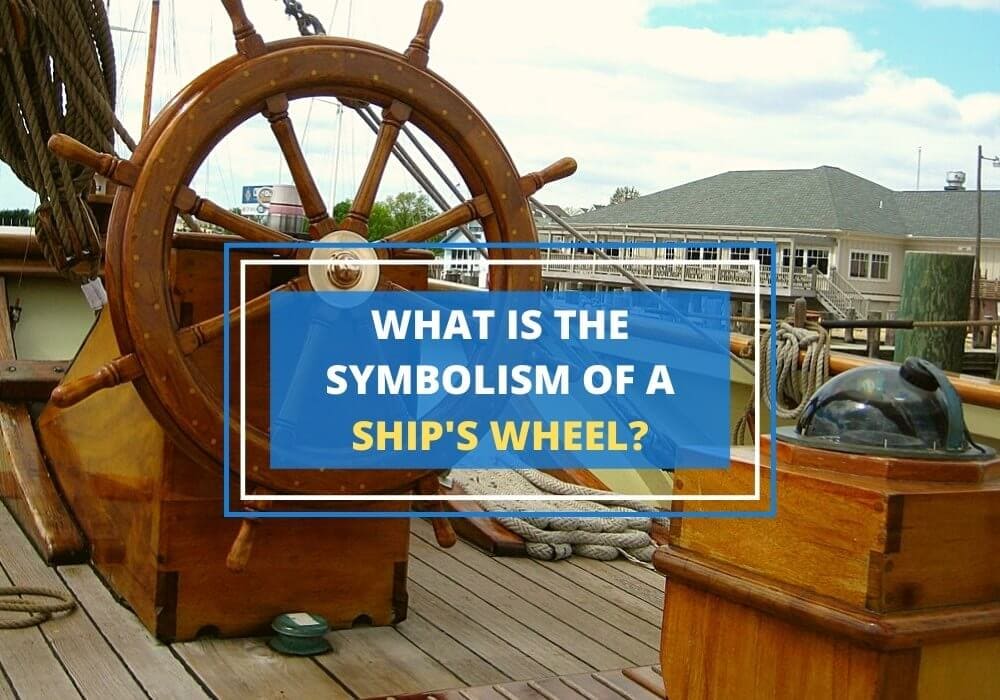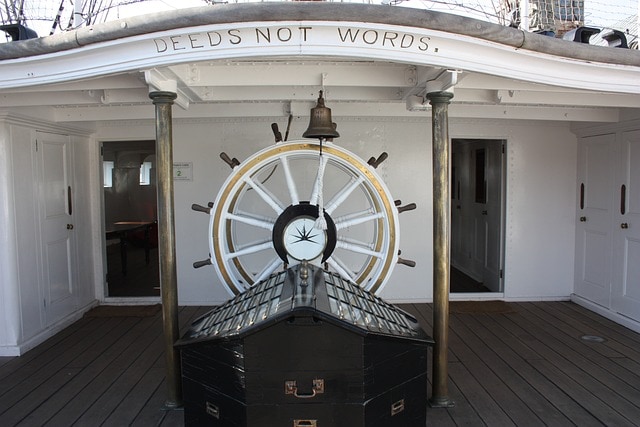
Table of Contents
The ship’s wheel is an important symbol in maritime culture. It’s not just for steering ships; it represents leadership, guidance, and handling life’s challenges. It stands for controlling one’s path and being resilient in tough times.
Let’s take a closer look at how the ship’s wheel, crucial for guiding ships, also carries significant cultural and personal meanings.
History of Ship’s Wheel

The ship’s wheel, a key symbol in maritime history, has evolved with the development of seafaring. Before the 18th century, sailors steered ships using a tiller, a lever directly linked to the rudder. As ships got bigger, using a tiller became too hard because of the physical effort needed. The early 1700s saw the invention of the ship’s wheel as a solution to this problem.
Its exact origins are a bit unclear, but most believe it started in Europe, with the British Royal Navy playing a major role in its early use and improvement. The ship’s wheel operated through a system of ropes and pulleys linked to the tiller, making it easier to steer larger ships by increasing the force the helmsman could apply.
This was a major step forward in sailing technology. The ship’s wheel made steering more precise and responsive, leading to safer and more efficient sea travel. It quickly became a standard part of ships, changing over time with new technology. The wheel’s design also changed, going from simple wooden wheels to more elaborate ones, showing off the craftsmanship and style of the time.
Even though modern ships now use advanced electronic navigation systems, the ship’s wheel is still a strong symbol of navigation and discovery. It represents the creativity and progress in naval technology and exploration.
Symbolism of a Ship’s Wheel

The ship’s wheel is more than just a tool for steering ships; it’s a symbol loaded with deep meanings.
1. Leadership and Authority
Practically, the ship’s wheel guides a ship through rough waters. Symbolically, it represents the qualities needed for good leadership, like decisiveness and strength. The person steering is often seen as a leader, guiding the way forward.
2. Journey and Exploration
The wheel also symbolizes adventure and the human journey. Historically, ships were the main way people explored new places. The wheel played a key role in these explorations, symbolizing the search for knowledge and new experiences. It reflects our natural urge to discover the unknown and learn more about our world.
3. Resilience and Steadfastness
The ship’s wheel stands as a strong symbol of resilience and steadfastness. When facing storms and rough seas, it represents the strength needed to overcome challenges. Just like a captain holding the wheel steady, it reminds us to stay firm and focused during tough times.
This symbol teaches us about staying strong in life’s difficult moments, suggesting that a firm grip on our own ‘wheel’ can lead us to safety and calm.
3. Change and Control
The ship’s wheel symbolizes our power to make changes and control our fate. It shows that everyone has the ability to change their life’s direction, just like a captain turns the wheel to steer the ship.
This symbol encourages us to take charge of our lives, make our own choices, and aim for our goals. It reminds us that, even though we can’t control everything, we can decide how to react and where to go.
4. Cultural and Historical Significance
Across cultures, the ship’s wheel has different meanings. Some see it as a lucky charm for safe journeys, while others view it as a symbol of freedom and new beginnings. It’s often seen as bringing good luck to mariners and travelers, and it represents endless possibilities and new starts on the open sea.
5. Balance and Harmony
The ship’s wheel also means balance and harmony. Steering a ship requires keeping the wheel balanced, just like balancing different parts of life is key to moving forward. It’s about finding the right mix of work, relationships, and personal development to ensure a smooth journey in life.
6. Artistic and Decorative Symbol
Beyond its deeper meanings, the ship’s wheel is a popular decorative piece. Used in art, literature, and design, it brings a sense of the sea’s romance and mystery. In homes, especially those with a nautical theme, it adds maritime charm. Whether in art, a book, or as a decor piece, the ship’s wheel captures the spirit of the sea and its timeless appeal.
Ship’s Wheel vs. Dharma Chakra
Because of how similar the dharma chakra and the ship’s wheel are, these two symbols are often confused. However, they’re not the same, but are two distinct symbols with different origins and meanings.
The ship’s wheel, used for steering a ship, symbolizes navigation, leadership, and guidance. It’s closely linked to maritime culture and the history of sea travel and exploration.
The Dharmachakra, found in Hinduism, Buddhism, and Jainism, represents the Buddha’s teachings and the path to enlightenment. Often called the “Wheel of Dharma” or “Wheel of Law,” it usually has eight spokes, each standing for the Noble Eightfold Path, a key part of Buddha’s teachings. This symbol is spiritual and religious, showing cosmic order and the way to nirvana.
In short, while both symbols may represent a journey, the ship’s wheel is tied to maritime tradition, and the Dharmachakra relates to the spiritual teachings of Eastern religions.
Symbolism of the Ship’s Wheel in Different Cultures

The ship’s wheel carries different meanings across the world, blending maritime traditions, history, and local beliefs. In Western cultures, it mainly symbolizes navigation, control, and guidance. It often stands for leading one’s life, with the person at the wheel representing a leader guiding through tough times. This symbolizes personal power to choose one’s path in life.
In maritime communities with a rich history of sailing, the ship’s wheel represents the heritage of naval exploration and trade. It honors the courage and adventurous spirit of sailors and explorers who braved unknown waters.
In some Asian cultures, people see the ship’s wheel as a symbol of luck and protection. It’s thought to bring good fortune and safety, especially for those traveling, because of the historical importance of the sea for trade and travel.
Globally in modern pop culture, the ship’s wheel stands for freedom and escape. It suggests the open sea’s vastness and starting fresh adventures. This idea appears often in literature, movies, and art, showing the wheel as a path to new beginnings.
In decorative arts and fashion, the ship’s wheel is a popular design element, especially in nautical themes. It brings up images of the ocean and exploration, appealing to those who love the sea’s romance and mystery.
The Ship’s Wheel in Fashion and Jewelry
The ship’s wheel, symbolizing navigation and maritime adventure, has carved a niche in fashion and jewelry. In fashion, designers frequently use the ship’s wheel theme in nautical-inspired clothes and accessories. Beyond the typical sailor stripes, the motif appears as buttons, t-shirt prints, and detailed embroidery on upscale clothing, adding a sense of adventure and a nod to sea romance and exploration.
In jewelry, the ship’s wheel is a favored design. Jewelry makers create various pieces like necklaces, bracelets, earrings, and rings featuring the ship’s wheel, blending elegance with a touch of the past. These pieces often recall distant places and sea journeys.
Designers sometimes embellish the wheel with gems or pair it with other sea-related symbols like anchors and compasses.
The ship’s wheel in fashion and jewelry also stands for guiding one’s own life, making it a meaningful choice for accessories. It reminds wearers of their personal ambitions, similar to steering a course in life.
Additionally, the ship’s wheel is part of vintage or retro-themed collections, harking back to the heyday of sea travel. Whether it’s a subtle hint or a bold centerpiece, the ship’s wheel brings a unique and stylish touch to both fashion and jewelry. It appeals to a wide audience, connecting the fascination of oceanic journeys with modern style.
Ship’s Wheel in Use Today
The ship’s wheel is a symmetrical and beautiful design that’s often adapted into jewelry designs, tattoos and decorative items.
As a unisex jewelry design, it’s most commonly used in pendants, on bracelets as well as earrings. Most ship’s wheel designs typically feature eight spokes and sometimes are combined together with an anchor for added nautical symbolism. Below is a list of the editor’s top picks featuring the ship’s wheel symbol.
As a tattoo, traditionally the design has been popular among sailors and lovers of the sea. However, due to the universal nature of its symbolism, tattoos featuring ship’s steering wheels are becoming increasingly popular.
Ship’s wheels are a must for any nautical collection. Overall, the design is an excellent choice as a gift for a range of occasions, especially as a Valentine’s Day, graduation, wedding, anniversary or goodbye gift.
Wrapping Up
The ship’s wheel has become a cultural icon and prominent symbol of the nautical world. Its universality makes it a much-loved symbol. Even if ship’s wheels eventually lose their practicality, with the advent of modern, more efficient nautical navigation inventions, it’s safe to say that the symbol will remain alive and well.











